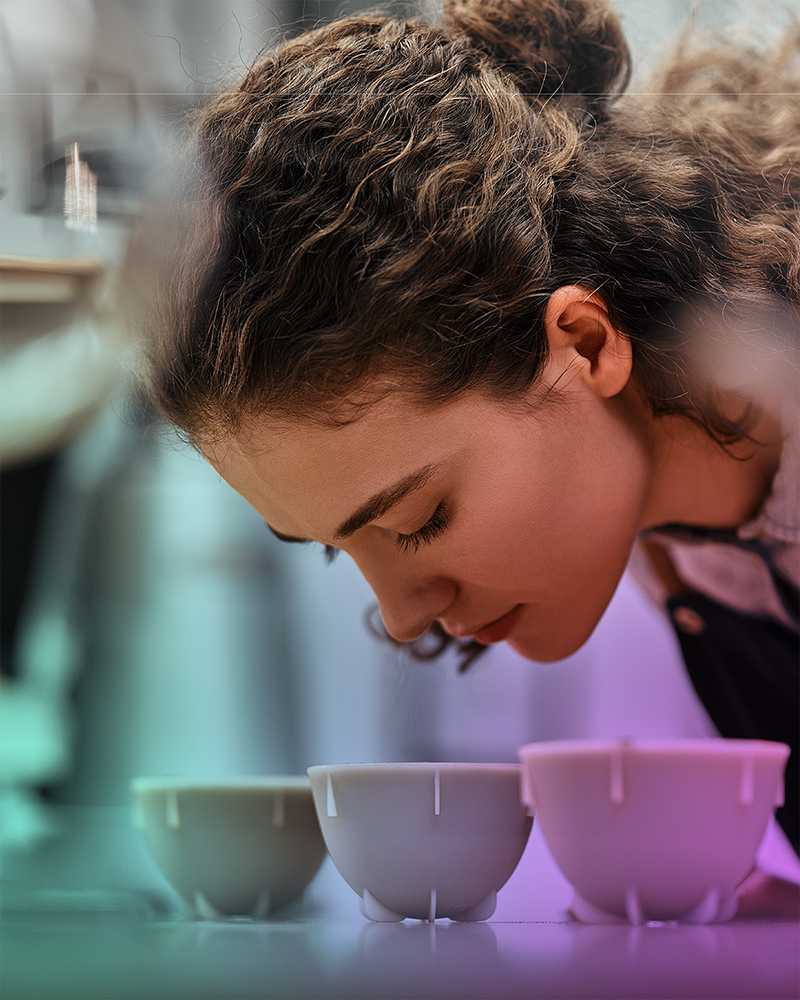ARTICLE
Cracking the Flavour Code: ProfilePrint’s Detection of Sensory Notes
Jul 3, 2024


Tasting by “Sight”
This simple phrase underpins how ProfilePrint’s analyser detects sensory notes.
Let’s first examine how we as humans perceive smell and taste. Every food that we eat or drink can be defined in terms of its chemical makeup. Beyond the well-known protein, fat and carbohydrates present which influence mouthfeel, food items contain a large variety of chemical compounds that are unique to them. These chemical compounds interact in distinct ways with the taste and smell receptors on our tongues and in our noses, giving rise to an interpretation in the brain. For example, the interaction of a family of natural compounds called chlorogenic acids found in coffee with the tongue causes us to interpret the coffee as ‘bitter’, ‘astringent’, or ‘acidic’ depending on the ratios and content of different chlorogenic acid family members. Studies have shown that every unique food sample produces a unique ‘sensory fingerprint’ signal in the brain. Based on this, there is thus a relationship that we can establish here:
Chemical makeup gives rise to a Sensory Interpretation in the form of taste and smell
In the field of spectroscopy, we probe chemical compounds by light waves, using not just the visible region to which our eyes are accustomed, but also adjacent regions such as UV (ultraviolet) and IR (infrared) “light”. These regions often see (literally!) more interactions with chemical compounds in food than the visible region and provide useful information consequently.

Chemical compounds interact with light waves by absorbing some types of light and reflecting other types, in a similar way to why we see green leaves as green because they absorb red and blue light. The interesting aspect of this is that depending on the unique chemical makeup of each food, the interaction detected through spectroscopy is also unique.
Therefore, by analysing the signals collected as a spectrum, we can establish a digital fingerprint unique to the analysed food sample. It follows that:
Chemical Makeup Gives Rise to a Spectral Fingerprint as ‘Seen’ by the Analyser
Now, we have two fingerprints. One is the sensory fingerprint that exists in our brains based on the signals from our tongue and nose receptors; the other is the digital fingerprint collected as light signals from a food sample’s interaction with visible and IR light.
Since both of these fingerprints have their basis in the chemical makeup of food, it, therefore, suggests that:
The Relationship Between the Sensory Interpretation and the Spectral Digital Fingerprint is Definable

Calculating this relationship using our proprietary algorithms is how ProfilePrint can unlock tasting by “sight”. Naturally, this is easier said than done. There are indeed some limitations to how much ProfilePrint can successfully emulate sensory interpretations. The first limitation is that we are only probing a portion of the light spectrum. As such, there may be missing signals that compromise the calculation of the relationship. Notwithstanding, ProfilePrint is actively looking into covering a larger portion of the spectrum in order to provide more complete digital fingerprints.
The second limitation pertains to very potent chemical compounds. Some compounds have an intense taste to them even at extremely low concentrations. This proves to be a challenge for the analyser as the device may not be sensitive enough to pick up the distinctive patterns due to these compounds.
In spite of the limitations, ProfilePrint’s technology manages to model sensory interpretations across a wide range of food substances and answers to a plethora of use cases, from a simple pass/fail assessment by taste to more complex taste profiles comprising 10 different flavour parameters.
Watch the Video
See ProfilePrint in Action
Let’s discuss how our technology can help with your quality challenges.
